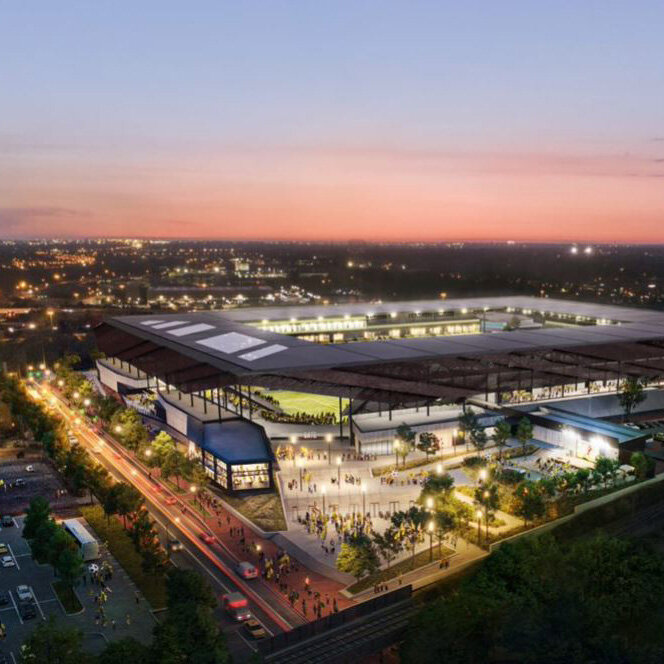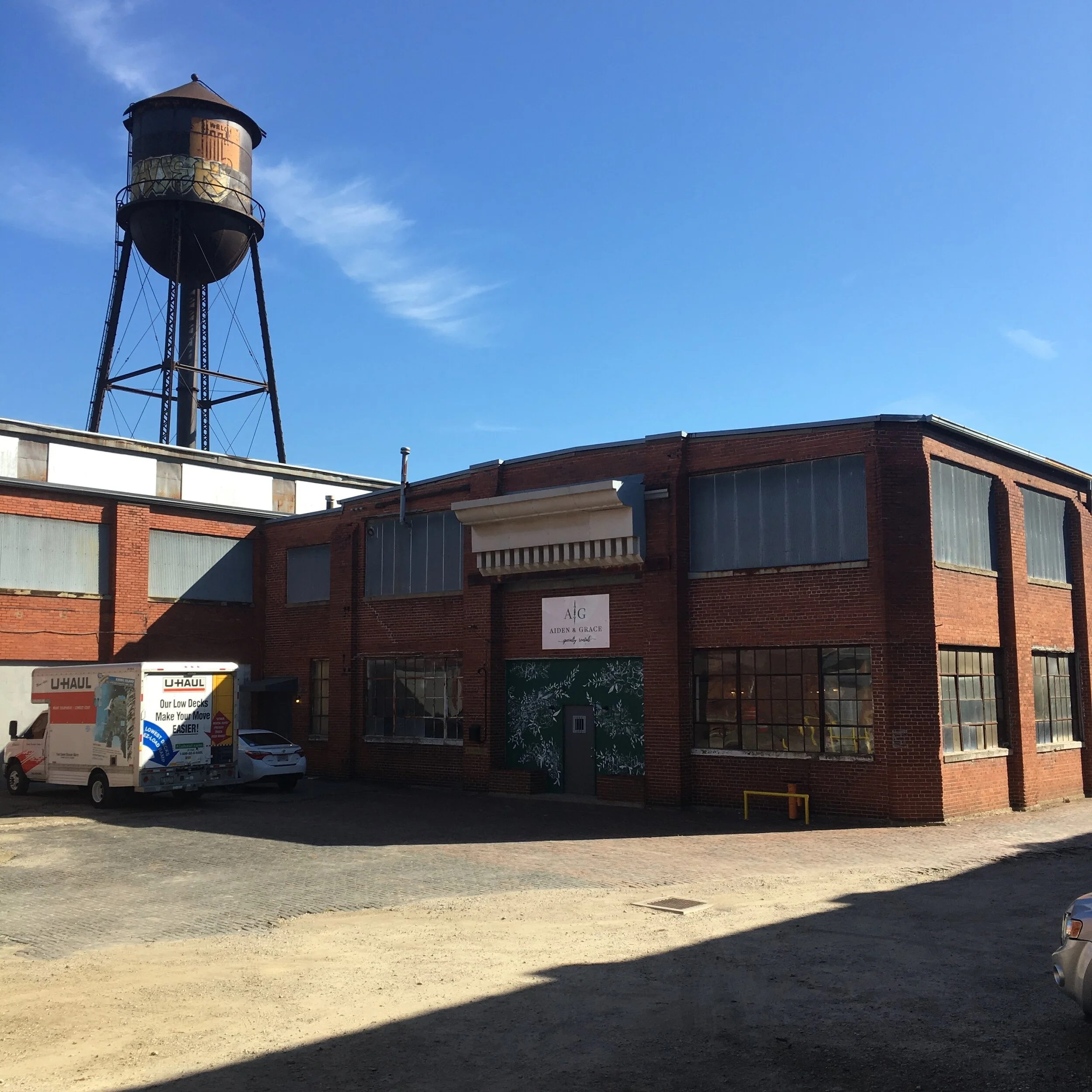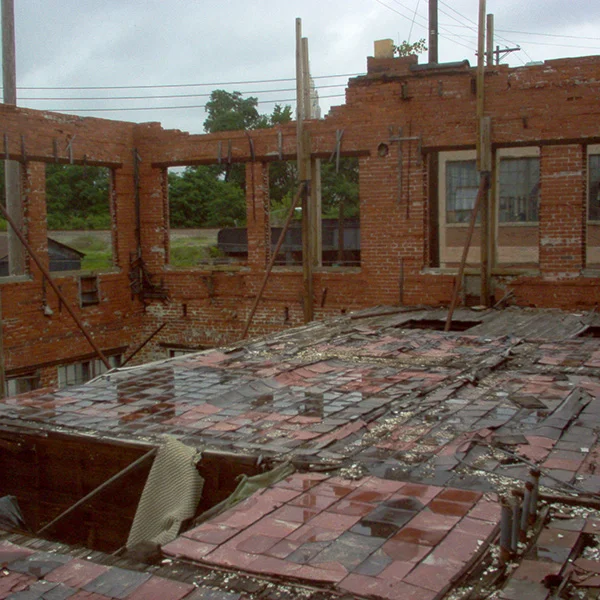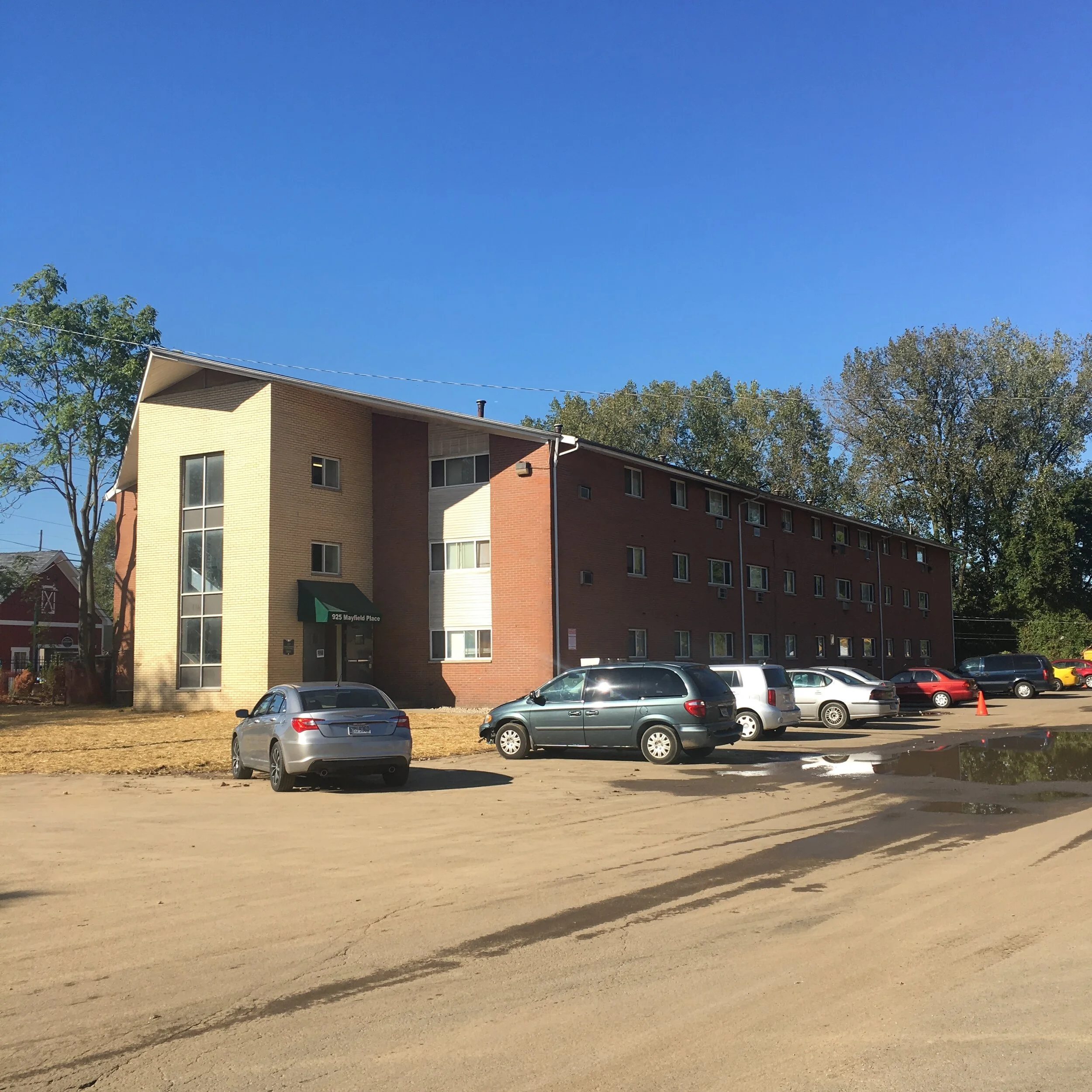
Crew Stadium / Former Jaeger Machine Co.
The site of multiple industrial complexes located in the heart of downtown Columbus.
The City of Columbus’s largest remaining piece of undeveloped land was the former home to multiple large-scale industrial facilities. The 19-acre property was originally developed in the late 1800’s and occupied for nearly a century by the Jaeger Machine Co., Union Tools Co., and Columbus Brass industrial facilities. This site, located in the Arena District, is now the future home of the Columbus Crew Soccer Club. Anticipated to be completed in time for the 2021 season, the property has undergone extensive remediation performed by PANDEY.
Historical use of the property impacted the on-site environmental media with hazardous chemicals and petroleum products including VOCs and Metals. Groundwater remediation was performed in the footprint of the future Major League Soccer Stadium area through the underground injection of a chemical reductive & dechlorinating solution. Additionally, a soil cap was installed and maintained across the property throughout the entire development of the property.
PANDEY worked with multiple Clients through ownership changes, managed all environmental investigations, performed VAP Phase I & Phase II Assessments, performed a Risk & Pathway Assessment, designed & implemented remedial activities, as well as prepared pre-construction plans (i.e. a Soils Management Plan & Groundwater Disposal Plan). We plan to continue to monitor the environmental conditions at the site after the Crew SC Stadium is completed, and intend to obtain a VAP Covenant Not to Sue for the property from the Ohio EPA, in the very near future.

Gowdy Field
Corporate office buildings on former urban landfill.
A former landfill is now home to The Ohio State University's- The Stefanie Spielman Comprehensive Breast Center, OSU Eye and Ear Institute, and Time Warner's Regional Headquarters. In addition to the construction jobs generated by redevelopment of this site; these three businesses support over 1,200 employees on-site.
Formerly known as Gowdy Field, this property was in a prime location; however, development was stymied due to its historical use as a solid waste landfill from approximately 1950 until 1969. Buried materials generated dangerous hydrogen sulfide and methane gas.
PANDEY secured $6 million in CORF cleanup grant funding for this property. We managed all assessment and remedial activities and continue to monitor environmental conditions at the site. We also obtained the first VAP Covenant Not to Sue for a former landfill property from the Ohio EPA.

Columbus - The Fort
A multi-use facility located in a commercial/industrial neighborhood within the city.
PANDEY was retained by Fortner Upholstering, Inc. requesting due diligence at a former industrial property on the South Side of Columbus. The property was originally developed in the late 1800’s and home of the Seagraves Fire Apparatus Company. Prior to its re-development as ‘The Fort Columbus’ the facility was mainly vacant. The developer saw the potential for the 273,000 square foot facility which contained historical architecture and was located along High Street, the artery of the City.
PANDEY performed a VAP Phase I and Phase II for the property. We discovered and removed multiple historical Underground Storage Tanks (USTs), provided long-term indoor air monitoring of the facility and designed a modern, effective remedial system to address the intrusion of harmful sub-slab vapors to the indoor air of the on-site buildings.
With PANDEY’s help in assessing the site, designing a sub-slab depressurization system and soil-vapor extraction system, ‘The Fort’ became one of the most unique multi-functional business complexes to exist in the historical Steelton neighborhood. We continue environmental monitoring at The Fort, and plan to obtain a Covenant Not to Sue (CNS) from the Ohio EPA in the very near future.

Cleveland, Ohio
City-Wide Urban Setting Designation expedites brownfield redevelopment in a rust-belt city.
PANDEY obtained the first Urban Setting Designation (USD) for an entire city in the State of Ohio. Typically, a USD is obtained at the property level. This pioneering project will save hundreds of millions in groundwater clean-up costs in the City of Cleveland. This single stroke of ingenuity promises to greatly expedite brownfield redevelopment.
The City of Cleveland also selected PANDEY to conduct activities under US EPA Brownfield Assessment grants. We have subsequently performed Phase I, Phase II, asbestos survey, risk assessment and remedial planning activities on several sites across the city.

Jefferson Smurfit
Vacant paper mill in a high-visibility site with funding challenges.
PANDEY was retained to conduct a Phase I Assessment at this property adjacent to the primary off-ramp into Circleville, Ohio. The intent was to secure grant monies to fund a Phase II assessment. Unfortunately, the fund ran out of monies before the application could be submitted. Rather than delay the project until the following year of funding, PANDEY was able to secure an Ohio Department of Development grant of $200,000 to fund the Phase II activities. After securing a $750,000 COAF grant to cover remediation costs, we obtained a Covenant Not to Sue from the Ohio EPA for the property.

Chillicothe Transit Center
Regional transportation hub on former railroad repair yard.
This centrally located site operated as a railroad maintenance yard from the 1890s to the 1970s. PANDEY applied for and received a Clean Ohio Remediation Fund grant for approximately $1,000,000. PANDEY managed site assessment, coordinated with ODOT which also provided grant funds, and implemented a remedy at the property. Risk assessment strategies employed by PANDEY reduced estimated remediation project costs by 50%. The site is now home to the Ross County transit center that allows for increased efficiency and better bus service to disadvantaged neighborhoods in Chillicothe.

Harrison Park West
Urban homes on former vegetable oil refinery site.
With an approaching deadline and consultants who failed to deliver, a local developer contracted PANDEY to complete the work at this site on the Olentangy River with over 100 years of industrial heritage. PANDEY quickly mobilized to obtain all the necessary data to create a remedial action plan, and apply for a $3 million Clean Ohio grant in a two and a half month timeframe. Remediation efforts included engineering a modified soil vapor extraction system to remove dangerous gases. This property was the first property in the state of Ohio with hydrogen sulfide gases to obtain a Covenant Not to Sue from the Ohio EPA. A few years later, stately historical style homes and complementary style condos adjacent to a riverfront park transform this former eyesore.

McArthur Lumber & Post
More accurate assessment results in continued operation of small-town lumber facility.
PANDEY addressed deficiencies in other consultant's work and generated data that resulted in 85% grant-funding of the approximately $1,000,000 assessment and cleanup costs. We obtained a Covenant Not to Sue (CNS) for this property after our remediation plan resulted in the removal of 10,000 cubic yards of impacted soil, provided for in-situ cleanup of contaminated groundwater, and implemented a Spill Prevention Control and Countermeasure Plan. Without the grant funding, the facility would likely have shut down; instead the facility is three times larger and employs additional employees in an economically depressed area.

Old St. Mary's School
Asbestos and lead paint abatement at a former home, school, and office building.
The property located at 673 Mohawk Street in Columbus, Ohio was originally a single family home built in 1887 and later converted to the St. Mary’s School. Following the construction of the St. Mary’s new facilities on nearby South 3rd Street, the old St. Mary’s building became the location of multiple office spaces, one of which was occupied by PANDEY Environmental.
In late 2012, Bob and Peggy Walter, founders of Cardinal Health, a fortune 500 company purchased the building and converted it to a 13,205 square-foot private residence. Prior to the purchase, the Walters retained PANDEY to perform a Phase I Environmental Site Assessment on the property to ensure no environmental impacts existed at the property (i.e. asbestos). We determined that asbestos containing materials and lead-based paint were present at the property that would require to be abated properly.
Following the abatement of the materials discovered in our Phase I, the Walters fully renovated the building into the second largest private residence in the City of Columbus. The new residential building has since been featured in Architectural Digest and on websites such as www.columbusunderground.com and www.dispatch.com.

Idea Foundry
Trade workshop on a former industrial production facility.
A.D. Farrow is America’s oldest Harley Davidson motorcycle dealership and occupied a storefront on West Broad Street just west of downtown Columbus. This dealership utilized a nearby warehouse on West State Street to store its motorcycle inventory and maintenance equipment. However, this warehouse was found to contain contaminated soils and petroleum free product beneath the basement slab due to historic property usage.
As the property was sold to Franklinton Development Association, PANDEY aided the property owner in taking the property through the Ohio EPA Voluntary Action Program (VAP) and was awarded a Covenant Not to Sue (CNS) by the Ohio EPA. This was made possible by imposing specific use restrictions to the future use of the property in addition to our implementation of remediation techniques that included “skimming” off and disposing of the petroleum free product floating on top of the groundwater table beneath the basement slab.
Now, the property is occupied by the Idea Foundry, a company that offers classes in various trades like bladesmithing, metalworking, welding, woodworking and also has workshop space available that can be used by independent renters to utilize state of the art techniques and machinery like 3D printers and plasma cutters. Also, the newly redeveloped 2nd floor offers event and office space for hosting any number of business applications.

Hudepohl Brewery
Asbestos abatement and debris management at a former brewery.
One of the mainstays of local Cincinnati beer manufacturing, the Hudepohl brewery was one of the few local breweries to survive prohibition and an onslaught of national competition. The Hudepohl brewery operated as a family owned business for 100 years until closing in 1987 and has been unoccupied since 1989.
PANDEY was approached by the Port of Greater Cincinnati Development Authority in 2013 to perform Phase I and Phase II Environmental Site Assessments at the former brewery site to ascertain any environmental impacts. Contamination was found to exist in the soil and groundwater. Furthermore, building material debris was found to be contaminated with hazardous substances including asbestos.
We designed and implemented a debris management plan to abate the asbestos containing materials from the partially demolished site and monitor the ambient air to ensure no airborne asbestos was generated during the abatement and additional demolition activities.

Hamilton, Ohio
Soil and ground water remediation at a former industrial production facility.
In a city that consistently wins awards for best drinking groundwater in the world, groundwater quality is a high priority. The 550 North 3rd Street property is located near the banks of the Great Miami River in Hamilton, Ohio and was the former location of industrial production facilities like Niles Tool Works and Champion Paper Company.
Due to historic site operations, in conjunction with being located adjacent to Chem-dyne, a chemical waste storage facility and high profile United States EPA superfund site, the groundwater at the site became significantly contaminated with volatile organic compounds (VOCs).
PANDEY developed and implemented a multi-phase groundwater remediation strategy that included the injection of a chemical oxidation agent component and a bio-augmentation component. The remediation strategy has since significantly reduced the concentrations levels of contaminating VOCs at the property. The property now has a Covenant Not to Sue (CNS) from the Ohio EPA.

B&T Metals / Eickholt Glass
Metal extrusion facility into mixed-use development.
Working with local officials, PANDEY secured a $750,000 Clean Ohio Assistance Fund (COAF) grant to pay for cleanup activities at B&T Metals/Eickholt Glass in Columbus, Ohio. The remediation is complete and the 4 acre site will be re-developed into a mixture of 132 live-work residences, retail space, office space, and accompanying greenspace. PANDEY has prepared a Phase I update, performed supplemental Phase II activities, obtained an Urban Setting Designation (USD) for the site, obtained a remediation grant, and is now managing ongoing operation & maintenance activities.

Newark
Soil and ground water remediation at a former industrial facility.
Living near a production facility can raise any number of environmental concerns for a private homeowner, as some of the residents living along Maple Avenue in Newark, Ohio came to find out. The facility located at 23 Sisal Street in Newark, Ohio was developed for commercial and industrial use in the early 1900’s and was occupied by a number of tenants over the years.
PANDEY was retained by the current property owner to conduct Phase I and Phase II Environmental Site Assessments at the site to identify environmental concerns. Contamination in the form of trichloroethene (TCE) was found to exist in the soil, groundwater, and soil gas beneath the property. Through the installation of many sampling points and the implementation of modeling techniques, we established migration pathways for soil gas that was found to be traveling off-site and onto nearby residential properties.
We performed several rounds of indoor air sampling within the residential houses suspected of being potentially impacted by the migrating soil gas contamination. One such residence was found to have concentrations of TCE in the indoor air of the basement at levels just above the Ohio EPA standard for indoor air. In this case, we aided in the design and installation of a Heat Recovery Ventilation (HRV) system in the basement of the residence to successfully lower the levels of TCE in the basement indoor air to acceptable levels.

Akron - Rolling Acres Mall
A former indoor mall located in the heart of a commercial area for the city of Akron.
The Northeast Ohio Four County Regional Planning & Development Organization (NEFCO) retained PANDEY for multiple Ohio EPA grant funded projects throughout Summit and Cuyahoga counties. One of note was the former Rolling Acres Mall property located in Akron. This 54 acre property was the home of one of the largest indoor malls of the region from 1976 through 2008.
PANDEY was retained to perform a Phase II Assessment at the property which took place during and after completion of the mall’s demolition. By satisfying requirements of the Phase II, the public entity, NEFCO, could proceed to prepare the property for redevelopment.

Cleveland - Opportunity Corridor
Conducted activities under state and private funded work to redevelop and repurpose the historical section of Cleveland.
PANDEY worked with the City of Cleveland on State funded work throughout an area identified as the ‘Opportunity Corridor’. Located on the southeast side of Cleveland, the area was densely occupied by manufacturing plants throughout the 1900’s and late 1800’s. These plants included the former Van Dorn Company facility (current home to the Orlando Baking Co.), and the former Victoreen Instrument facility.
The City of Cleveland selected PANDEY to conduct activities under the State & private funded work for multiple properties in the neighborhood as part of their plan to redevelop and repurpose use of this historical section of Cleveland. PANDEY performed VAP Phase I Reports, Phase II Reports, Asbestos Surveys, Risk Assessment, Remedial Excavations, Ohio EPA Technical Assistance Packages, and Ohio EPA No Further Action (NFA) Packages for sites located within the ‘Opportunity Corridor’.

Cuyahoga Falls - Mud Run Gun Club
A former shooting range located in a residential neighborhood desiring a park.
The Northeast Ohio Four County Regional Planning & Development Organization (NEFCO) retained PANDEY to investigate a vacant field located in a residential part of Cuyahoga Falls. The site was the former location of the Cuyahoga Falls Mud Run Gun Club, which was a clay pigeon shooting range. Mud Run Creek cut through the property in the area where the shooting range formerly existed.
PANDEY was brought in to perform a Remedial Investigation Report (RIR) following Ohio EPA VAP standards in order to address data gaps presented in previous environmental assessments prepared for the property by other contractors. PANDEY’s RIR not only served to address data gaps left by former environmental investigations, but also provided significant data (which previously was unaddressed) on the impact to Mud Run Creek’s sediment from the clay pigeon and buck-shot deposits leftover by the historical gun range. With this information and statistical analysis, we developed a Remedial Action Plan (RAP) for the property which established remedial objectives and detailed activities which could be implemented at the property in order to address environmental risk to future receptors and prepare the site for redevelopment.

Bexley - Ferndale-Mayfield Corridor
A former landfill site located under residences in an affluent suburb.
Nestled in the City of Bexley, one of Columbus’s premiere suburbs is the location of a former landfill. The property was developed in the 1960’s with residential homes and apartments without knowledge that the site was the former location of an unlicensed landfill for residential waste in the 1930’s-40’s. This site is the not only home to many local families, but also the home to the community garden, recreational fields and a playground.
PANDEY confirmed through VAP Phase I & Phase II environmental assessments that the property was in fact, the location of a former unlicensed landfill. Furthermore, our assessment demonstrated that excess risk existed to on-property residents from exposure to Metals and potentially from vapor intrusion into homes from harmful landfill gases.
We assisted in securing a $300,000 loan from the Ohio Water Development Authority in order to properly assess the risk to on-site residents and perform remedial activities at the property. With the OWDA loan, contaminated soils can be excavated, hauled off-site and replaced with a soil cap.


















